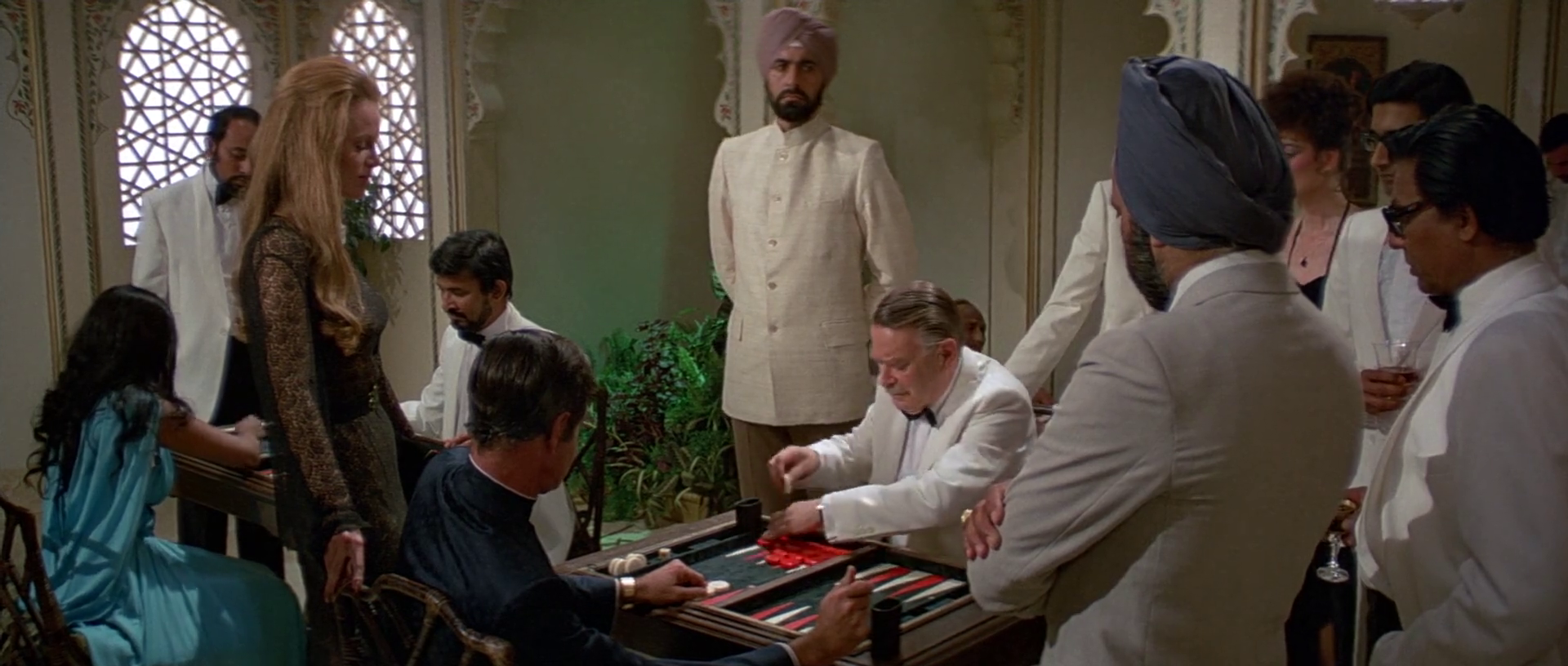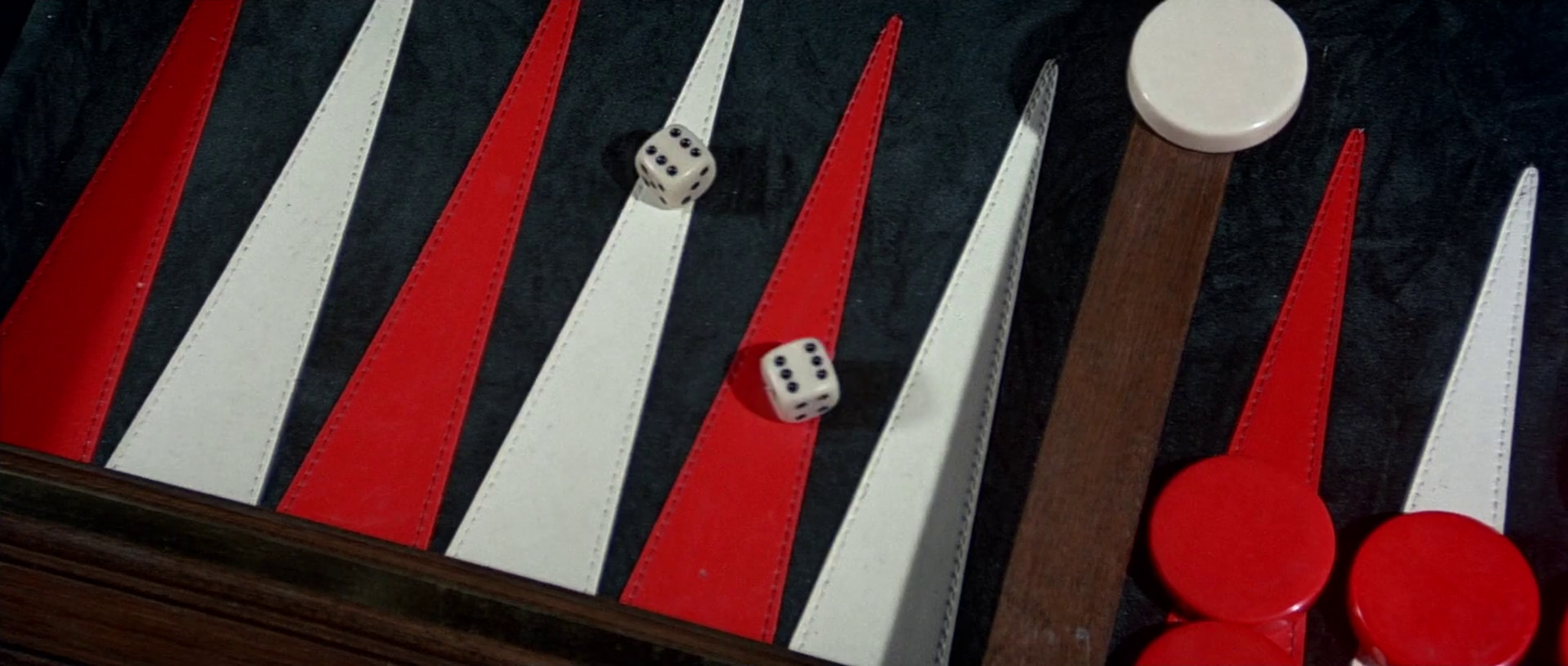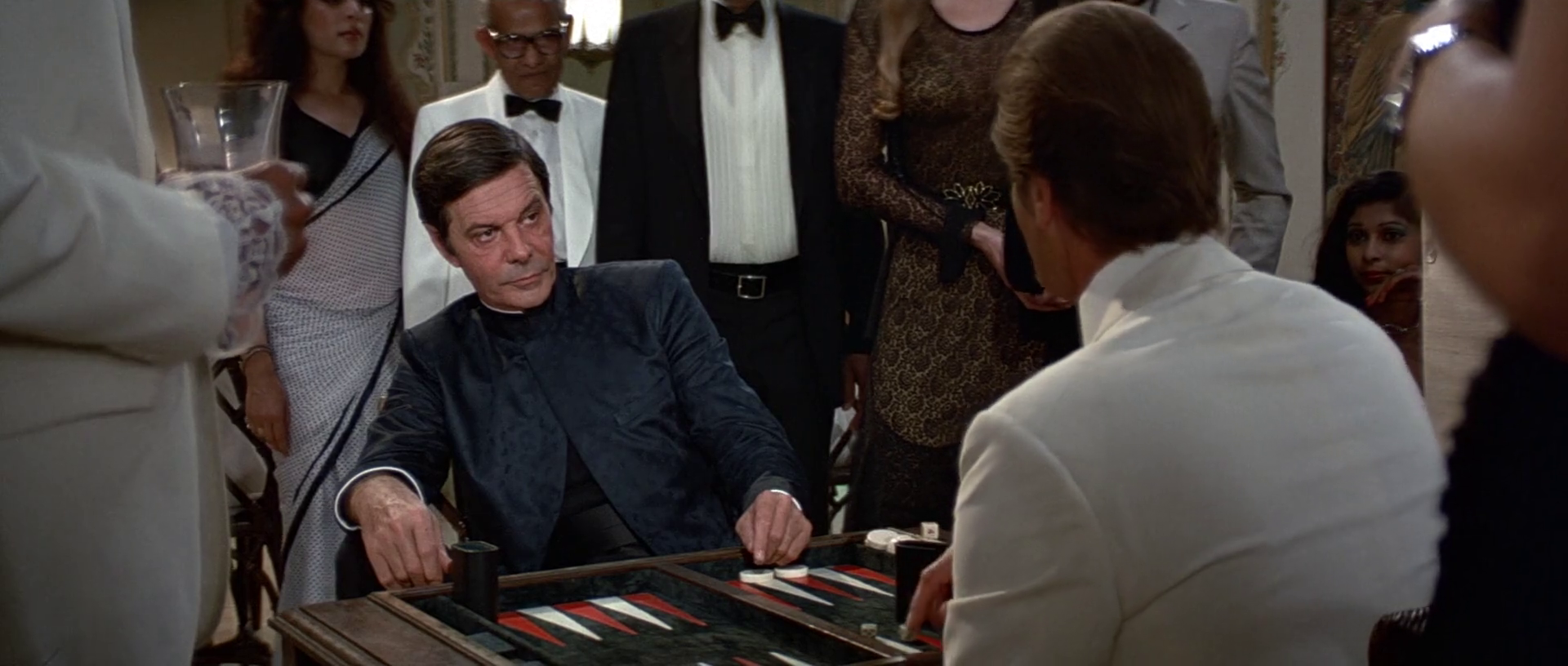Octopussy (1983)
An annotated backgammon timeline.
Bond, being Bond, is perpetually a master of contemporary gaming: Baccarat (1962, 1965, 1969, 1981, 1995), Gin Rummy (1964), Golf (1964), Craps (1971), Backgammon (1983), Domination (1983, anticipating the electro-shock video-game trend), and No-Limit Texas Hold’em (2006). While many of these adventures stretch probability and strategy to their breaking points, Octopussy’s backgammon scene stands out for thoroughly mangling the rules of the game.
Backgammon is primarily a race, and the best roll for racing is double sixes. But backgammon is not only a race -- if it were, there would be precious little strategy. There are also hitting and blocking. Depending on the position, 66 may be the best roll or may be the worst. This subtlety was lost on set.
Here's a low-res video, followed by the annotated timeline.
(29:31) Bond: “How is he doing?” Sadruddin: “The Major’s no novice. But Kamal has taken 200,000 rupees.”
(29:35) The Major (red) completes the close-out . . .
. . . and puts Kamal Khan’s white checker on the bar. (Note that both player’s dice cups are appropriately off of the playing surface.)
(29:37) The Major: “You’ll have a job beating that!” Kahn: “I feel lucky. Shall we double?” (1.) This is not idiomatic. “We” do not double. One player offers a double, saying, “Double,” or “I double,” and by placing the cube on the playing surface. The other player may Take or Pass. To Take, he places the cube on his own side of the board, still visible, but off the playing surface. To Pass, he replaces the cube at the midpoint of the board between the players (off to the side) and resets the checkers for the next game.
The Major: “Of course.” This is also the wrong idiom, but is consistent with how Kahn asked the question.
(29:46) Kahn places the doubling cube on the Major’s side of the board. (2.)
This is poor etiquette -- similar to taking someone else's poker chips from their stack and putting them into the pot after they say “I call.” The Major should take the cube himself.
We can see enough of the position in the shot above to understand what is happening in the game. Kahn has already taken off several checkers -- the checkers on his far left that are off the playing surface and stacked on edge. His remaining checkers are on his 2 and 4 points, but his ace and 3 points are empty. The Major must have owned one or both of those points and hit Kahn while Kahn was bearing his checkers off. Subsequent to the hit, the Major moved all his checkers around to his side of the board and completed the close-out. This all looks normal and appropriate. Someone on set had actually played a game of backgammon.
(29:46) “Twenty thousand rupees.” We can infer they must be playing for 10,000 per point. The exchange rate at the time was roughly 10 rupees per dollar, so they are playing for roughly 1,000 dollars -- 1,000 nineteen eighty-three dollars -- per point. A significant stake.
(29:47) Kahn switches dice.
(29:53) Kahn rolls 66. (He should not be rolling since he is closed out. But occasionally a player who is closed out will roll anyway, on autopilot, and then realize he has no way to enter and sheepishly pick up his dice. So I call this no error.)
But the dialog proceeds as though Kahn has rolled some great number. The Major: “Damn! Always a double six when you need it!” Kahn: “Always.” The Major: “How do you do it?” Kahn: “It’s all in the wrist.” The Major: “Oh, it’s hopeless.” Kahn: “Shall we have another game, Major?” Kahn places some checker (which checker?) on his own ace point. “Same stake?”
(30:05) Here is a shot after Kahn asks “Same Stake?” and before the Major says “Yes, I’ll have another go.”
(30:05) The Major: “Yes, I’ll have another go. Your luck’s got to run out sometime.”
(30:10 -- 30:40) Interlude with Bond at bar.
(30:51) We return to a new game in progress. Note that both dice cups are on the playing field (5.) , which would never happen during play since they hide the position from the view of the players. Imagine two chess players resting their water glasses directly on the chess board, mixed in with their pawns, while playing an important game.
Also, weren’t they just playing for 10,000 rupees per point? You can’t get to 100,000 rupees that way. (7.) The game starts at 10,000 rupees (1 point). There’s a double to 2 (20,000 rupees), which is what happened last game. Then perhaps a redouble to 4 (40,000), and then perhaps another redouble to 8 (80,000), and then in a crazy game perhaps a redouble to 16 (160,000 rupees). You can’t get to an even 100,000 rupees. It’s a “doubling” cube, not no-limit poker. (Maybe they raised the stakes to 25,000 rupees per point while Bond was at the bar? Maybe. But the last lines we heard from them were “Same stake?” and “Sure, I’ll have another go.” So it goes on the list.
(31:02) Once again, Kahn places the cube on the Major’s side of the board. Poor etiquette.
(31:07) The Major: “I can’t accept. Not with your luck.” Ok, but note that the Major is actually winning in this position. He’s the favorite. If he’s now going to pass a double when he’s the favorite it seems pretty clear he shouldn’t have agreed to another game. This would be like agreeing to play another hand of high-stakes poker with a guy you think is crazy lucky, being dealt a full house and getting all excited, but then folding when your crazy lucky opponent bets at you. If you were going to fold when you have a full house, why did you agree to play? (No error -- people do silly things when gambling.)
(31:13) Bond: "I would have taken that double, myself.” Kahn: “Then why don’t you take over the Major’s position? Mr . . .?” “Bond. James Bond. I’d be delighted.” “One hundred thousand rupees, then.” This is not as crazy as it looks. Backgammon is a gambling game and it is common for players to engage in side bets on games they are not actually playing. Sometimes they even enter and take over games in progress. It doesn’t work exactly like this, but pretty close.
(31:33) Kahn rolls 66. Kahn: “It was not such a good double to accept after all, was it?”
(31:48) Bond redoubles by taking the cube and placing it on Kahn's side of the board. (Again, poor etiquette, but perhaps he’s seen that’s how they do it over here.) Bond: “Double.” Kahn: “Of course! You can only win with a double six! (8.)” That’s actually not at all correct, as we will see in the final screenshot.
(32:22) Kahn: “You need a great deal of luck to get out of this.” Bond: “Oh, luck? Well, then I shall use player’s privilege . . .” Bond dumps his own dice into the corner of the board, grabs Kahn’s cup, and takes Kahn’s dice. “. . . and use your lucky dice.”
Of course this would never ever happen. There are rules regarding dice mixing. But we’re in a Bond film so I allow it.
(32:45) Bond rolls 66 and removes his four checkers, winning the game. (Placing his dice cup on the board is not so bad in this case since the game is now over.)
But look at Kahn’s checkers: Kahn has one checker each on his 3 and 4 points. Had Bond not rolled 66, Kahn would not be a lock to win the game from here. In fact, he’s not even a favorite to win on this shake: 17 rolls let him take off both checkers and win while 19 rolls don’t.
There you have it. Eight backgammon mistakes in three minutes of screen time (including a suave interlude at the bar).







